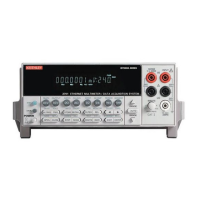7-26 Scanning Model 2701 User’s Manual
Remote programming — scanning
NOTE Scanning examples (remote programming and front panel operation) are
provided at the end of this section.
Trigger model
The trigger model for bus operation is shown in Figure 7-2. Bus operation is similar to
front panel SCAN operation, with the following significant differences:
Idle — The instrument goes into the idle state (measurements halted) after the last scan
channel is measured. For front panel operation, the instrument stays in idle until the next
scan is started. For bus operation, the instrument will not stay in idle unless continuous
initiation is disabled. There are two commands to disable continuous initiation:
INITitate:CONTinuous OFF ' Disable continuous initiation.
*RST ' Restore *RST defaults.
The instrument will remain in idle until it receives an initiate command. Typical
commands to initiate one scan cycle include:
INITiate' Initiate one scan cycle.
READ? ' Initiate one scan cycle and request "sample" readings.
More information on using these commands is provided by Reference c that follows
Table 7-1.
Control sources — For bus operation, there are two additional control sources: Bus and
Manual. For the Bus control source, scan operation is controlled by bus triggers (i.e.,
*TRG) or by using the TRIG key. For the Manual control source, event detection is
controlled solely by the TRIG key. Note that the instrument has to be in local order to use
the TRIG key. The LOCAL key takes the instrument out of remote.
Trigger and sample counters — For front panel SCAN operation, the number of
channels in the scan list and the programmed reading count automatically sets the trigger
and sample counters. For remote operation, these two counters are set by the
TRIGGer:COUNt and SAMPle:COUNt commands.
NOTE To set sample count >1, continuous initiation must be disabled (see “Idle,”
page 7-7). Note that only sample count readings are stored in the buffer. See
Section 8 for detailed information on the trigger model.

